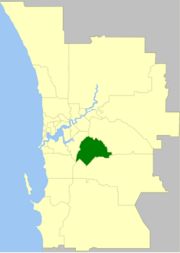City of Gosnells
|
City of Gosnells Western Australia |
|||||||||||||
|---|---|---|---|---|---|---|---|---|---|---|---|---|---|
 |
|||||||||||||
| Population | 125,051 (2015 est) | ||||||||||||
| • Density | 977/km2 (2,530/sq mi) | ||||||||||||
| Established | 1907 | ||||||||||||
| Area | 128 km2 (49.4 sq mi) | ||||||||||||
| Mayor | Cr Olwen Searle | ||||||||||||
| Council seat | Gosnells | ||||||||||||
| Region | SE Metropolitan Perth | ||||||||||||
| State electorate(s) | Cannington, Gosnells, Jandakot, Kalamunda, Southern River | ||||||||||||
| Federal Division(s) | Hasluck, Canning | ||||||||||||
 |
|||||||||||||
| Website | City of Gosnells | ||||||||||||
|
|||||||||||||
The City of Gosnells is a local government area in the southeastern suburbs of the Western Australian capital city of Perth, located northwest of Armadale and about 20 kilometres (12 mi) southeast of Perth's central business district. The City covers an area of 128 square kilometres (49.42 sq mi), much of which is state forest rising into the Darling Scarp to the east, and had a population of 106,585 at the 2011 Census.
The name Gosnells dates back to 1862 when Charles Gosnell who was the owner of London cosmetic company John Gosnell & Co., bought Canning location 16 from the Davis family who were the original grantees in 1829. While the purchase of the land was a personal investment by Charles Gosnell, when the land was sold to developers in 1903 the developers used the association to the well known cosmetic company, claiming it had bought the land because of its fertile soil to grow flowers for the manufacture of its perfume range. The abundance of the Arum Lily (Zantedeschia aethiopica) in the area and the marketing by the developers contributed to the myth about the Gosnell company, being so successful that the Gosnells railway station was constructed on the Armadale line in 1903.
Gosnells Road District was created out of the abolished Canning Road District on 1 July 1907. Industry in the form of brickworks were introduced to Beckenham in the early 1990s. Between 1912-15 fruit fly wiped out nearly all of the stone fruit crops in the region and many farmers turned to dairying and market gardening. Irrigation was vital due to sandy, infertile soils of Canning Vale. In 1923, the City received land from Jandakot Road District when that entity was abolished. Significant development did not occur until the post-war years. The population grew from 7,400 in 1954 to about 11,000 in 1966, and then to 21,000 in 1970. On 1 July 1961, Gosnells Road District became a Shire following enactment of the Local Government Act 1960. On 1 July 1973 it became a Town and exactly four years later it attained City status.
...
Wikipedia
